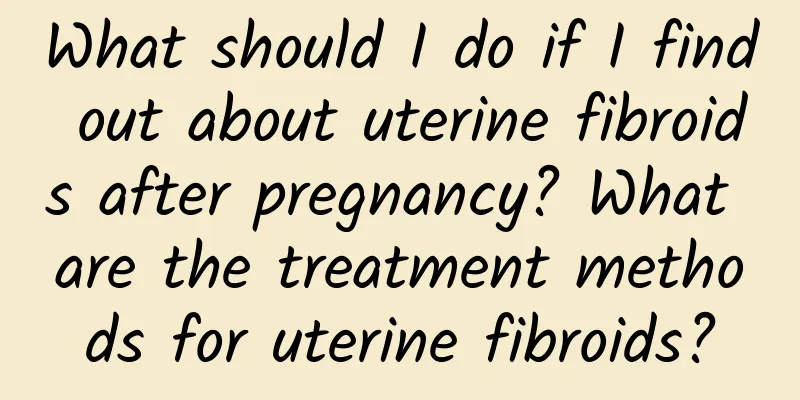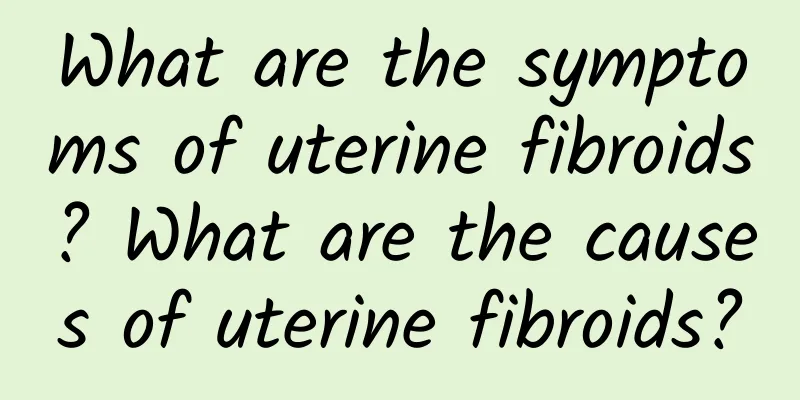What should I do if I find out about uterine fibroids after pregnancy? What are the treatment methods for uterine fibroids?

|
During pregnancy, if there are uterine fibroids, it will definitely have a certain impact on pregnancy, including high miscarriage rate, malposition of fetus, high rate of dystocia, high rate of cesarean section, large amount of postpartum hemorrhage, etc. After pregnancy, the hormone level in the body rises, and uterine fibroids are likely to continue to increase, and even lead to fetal maldevelopment and miscarriage. Uterine fibroids will change as a woman's pregnancy progresses, some uterine fibroids will change position, some uterine fibroids will gradually increase in size, and some uterine fibroids will cause abdominal pain and uterine contractions due to tissue congestion and thrombosis after pregnancy. This is very threatening to pregnancy. However, the incidence of serious complications is very low. If a pregnant woman has serious complications during pregnancy, such as premature birth, obstructed labor, or postpartum hemorrhage, she may consider myomectomy before the next pregnancy. What should I do if I find uterine fibroids after pregnancy? Uterine fibroids are the most common benign cavity tumors among female friends. Women of childbearing age have a high chance of developing uterine fibroids, but fortunately, most uterine fibroids are benign and the chance of malignant lesions is very low. Therefore, as long as uterine fibroids are treated in time, harm to women's health can be avoided. For women who discover uterine fibroids after pregnancy, From the perspective of obstetrics and gynecology, the treatment of uterine fibroids should be determined based on the size, location, symptoms, patient age, fertility requirements, recent developments and complications, and whether the diagnosis is clear. 1. If the diameter of the uterine fibroid is less than 6cm and there are no particularly obvious symptoms, regular prenatal examinations should be performed to pay attention to whether the fibroid has red degeneration. Most pregnant women can give birth vaginally without special treatment. If the diameter of the uterine fibroid is larger than 6 cm, the development of the fibroid should be closely observed during regular prenatal checkups. When the pregnancy exceeds 37 weeks, the mode of delivery should be determined based on the location of the fibroid, the condition of the fetus and the pregnant woman. During pregnancy, the uterus is an organ rich in blood, especially in the late pregnancy. If a myomectomy is performed during delivery, it will increase a lot of unnecessary bleeding and make it more difficult to stop bleeding. 1. Avoid dystocia. In order to avoid dystocia, it is necessary to deliver the baby before delivery. At the same time, the possibility of dystocia can be predicted by B-ultrasound examination, abdominal palpation and other means before delivery, and cesarean section should be selected to terminate the pregnancy. 2. Hospitalization. If uterine fibroids are discovered after pregnancy, hospitalization must also be considered. During pregnancy, most pregnancies combined with uterine fibroids can be successfully completed, but in the following situations, hospitalization may be required during pregnancy: first, the symptoms of necrosis (red degeneration) are severe; second, the subscapular fibroid pedicle is twisted, causing severe abdominal pain and vomiting; third, most multifollicle fibroids combined with early pregnancy require childbirth. 3. Take surgical treatment seriously. Generally speaking, surgical treatment can stimulate uterine contraction, leading to the possibility of miscarriage or premature birth. Therefore, surgical treatment should be treated carefully if it is not necessary, and for patients with uterine fibroids found after pregnancy, the surgical requirements are higher than the general surgical requirements. If necessary, surgical treatment should be performed in the second trimester. At this time, because the placenta is well developed, the uterus is not too large, and the external stimulation is low, the possibility of premature birth and miscarriage will be greatly reduced. What should I pay attention to if I have uterine fibroids after pregnancy? 1. After pregnancy, you must undergo regular pregnancy checks as required by your doctor so that you can keep track of the growth of the fetus and fibroids and take timely measures. 2. After a woman becomes pregnant, uterine fibroids will grow rapidly and may also become red due to thrombosis, which is mainly manifested as lower abdominal pain, nausea, vomiting, etc. Most of the pain will be relieved on its own. If it cannot be relieved, surgery to remove the fibroids should be considered. 3. In late pregnancy, uterine fibroids may also be combined with incorrect fetal position, which may lead to uterine atony or delayed labor during delivery. At this time, the doctor needs to take emergency measures according to the condition of the fibroids, such as cesarean section or fibroid removal. 4. Avoid moderate or severe physical labor and rest in bed if necessary. 5. Increase nutrition, especially eat more blood-enriching foods, such as duck blood, animal liver, wolfberry and jujube porridge, sesame paste, shepherd's purse, spinach, etc., to prepare for bleeding. 6. Adjust your mentality. Experts point out that you should consciously improve your psychological endurance. Because pregnant women with uterine fibroids are more likely to have abnormal pregnancies such as miscarriage and dystocia than normal people. In addition, you must be mentally prepared for cesarean section and maintain a positive and optimistic attitude. 7. First of all, you should strictly control your sex life. After you are sick, you should pay attention to controlling your sex life, which can effectively reduce the probability of miscarriage and infection. Avoid all physical labor. If necessary, you should pay attention to bed rest. |
<<: What should I do with uterine fibroids? Three surgical treatments for uterine fibroids
>>: What should I do if I have uterine fibroids? Treatment of uterine fibroids
Recommend
What's wrong with taking emergency contraceptive pills and having periods twice a month?
What's wrong with taking emergency contracept...
Two major misunderstandings in the treatment of uterine fibroids
There are two common misunderstandings about the ...
How to treat bacterial vaginitis?
How to treat bacterial vaginitis? Bacterial vagin...
Which is less harmful, surgical abortion or medical abortion? Let's find out
Generally speaking, many women who have an unexpe...
How to repair vulvar skin lesions after treating vulvar leukoplakia?
Patients with vulvar leukoplakia should all know ...
Patients with dysmenorrhea should combine their treatment methods as soon as possible
The occurrence of dysmenorrhea will damage the he...
Sugar is the "fire of inflammation" in the body and can cause bone and muscle loss! Nutritionist: How to manage a sugar-reduced or sugar-free diet
The body's "inflammatory fire" come...
There are many reasons why menopause is difficult to cure
Menopause is a necessary stage for every woman. I...
How should patients with dysmenorrhea be treated and nursed back to health?
Many women suffer from dysmenorrhea, so dysmenorr...
What should you not eat if you have uterine fibroids? Top 10 foods that are forbidden for uterine fibroids
What should you not eat if you have uterine fibro...
Follow-up care after surgery for Bartholinitis
Bartholinitis refers to inflammation caused by pa...
Just love wearing high heels? 4 groups should be careful to prevent patellar valgus
I’m still young, but my knees always ache. Could ...
Can Guizhi Fuling Pills treat uterine fibroids?
Guizhi Fuling Wan is a traditional Chinese medici...
What are the causes of ectopic pregnancy?
Ectopic pregnancy, also known as ectopic pregnanc...
What should I do if I have a stomachache three days after abortion?
What should I do if I have a little stomach pain ...









